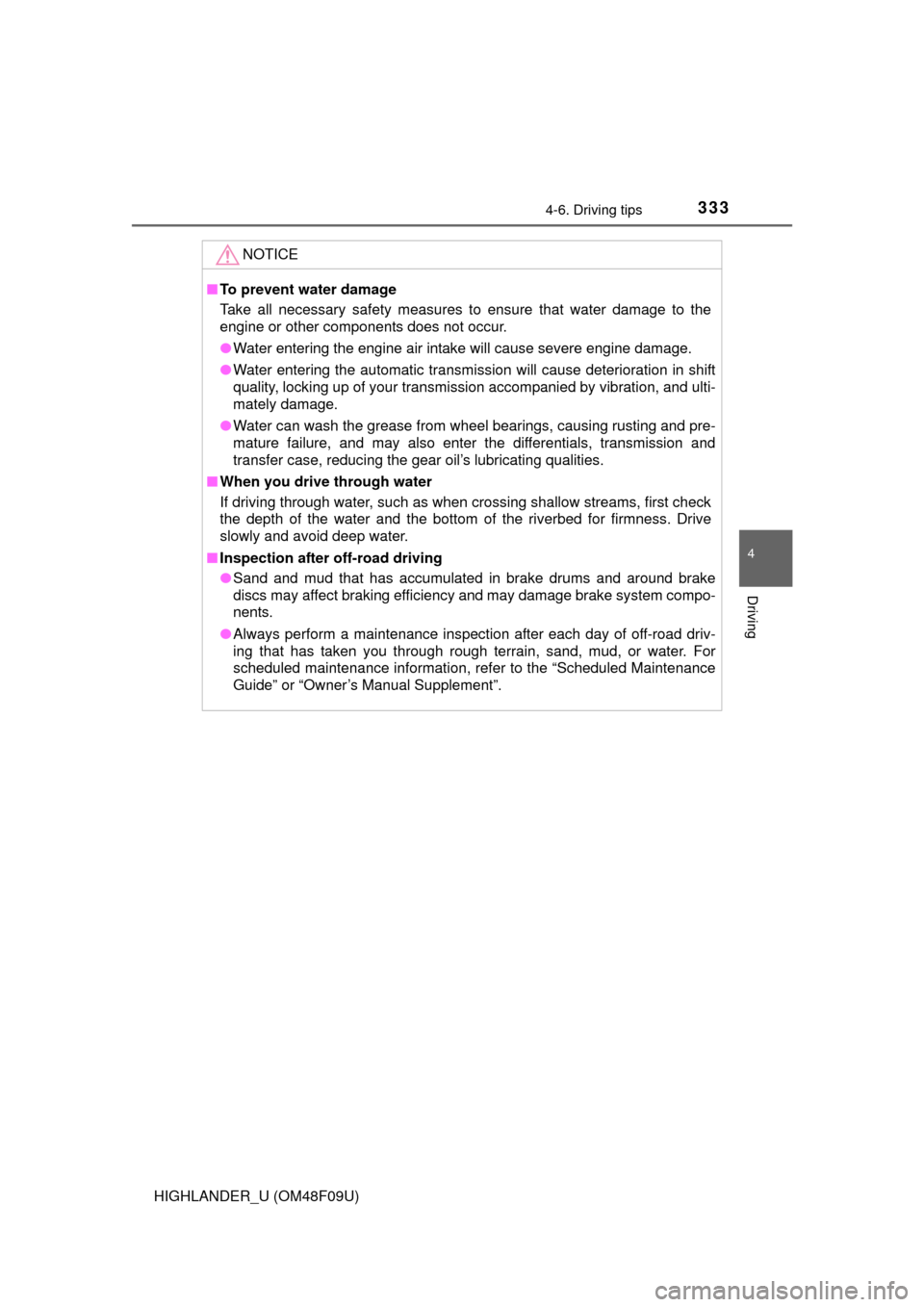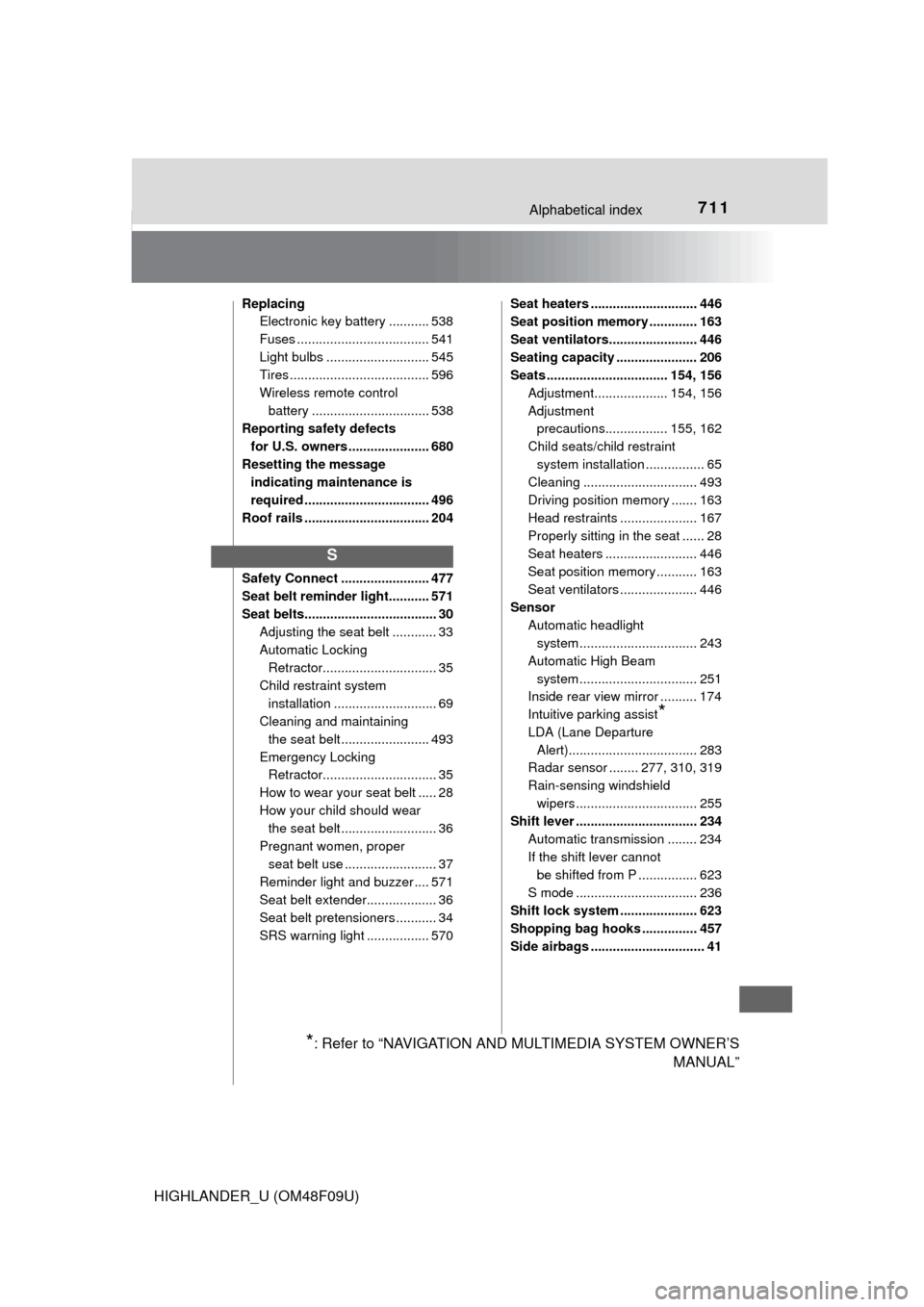Page 221 of 716

2214-1. Before driving
4
Driving
HIGHLANDER_U (OM48F09U)■
Break-in schedule
If your vehicle is new or equipped with any new power train components
(such as an engine, transmission, differ ential or wheel bearing), Toyota rec-
ommends that you do not tow a trailer until the vehicle has been driven for
over 500 miles (800 km).
After the vehicle has been driven for over 500 miles (800 km), you can start
towing. However, for the next 500 miles (800 km), drive the vehicle at a speed
of less than 50 mph (80 km/h) when towing a trailer, and avoid full throttle
acceleration.
■ Maintenance
●If you tow a trailer, your vehicle will require more frequent maintenance due
to the additional load. (See “Scheduled Maintenance Guide” or “Owner’s
Manual Supplement”.)
● Retighten the fixing bolts of the towing ball and bracket after approximately
600 miles (1000 km) of trailer towing.
■ If trailer sway occurs
One or more factors (crosswinds, passing vehicles, rough roads, etc.) can
adversely affect handling of your vehicle and trailer, causing instability.
●If trailer swaying occurs:
• Firmly grip the steering wheel. Steer straight ahead.
Do not try to control trailer swaying by turning the steering wheel.
• Begin releasing the accelerator pedal immediately but very gradually to reduce speed.
Do not increase speed. Do not apply vehicle brakes.
If you make no extreme correction with the steering or brakes, your vehicle
and trailer should stabilize.
● After the trailer swaying has stopped:
• Stop in a safe place. Get all occupants out of the vehicle.
• Check the tires of the vehicle and the trailer.
• Check the load in the trailer.
Make sure the load has not shifted.
Make sure the tongue weight is appropriate, if possible.
• Check the load in the vehicle. Make sure the vehicle is not overloaded after occupants get in.
If you cannot find any problems, the speed at which trailer swaying occurred
is beyond the limit of your particular v ehicle-trailer combination. Drive at a
lower speed to prevent instability. Remember that swaying of the towing vehi-
cle-trailer increases as speed increases.
Page 333 of 716

3334-6. Driving tips
4
Driving
HIGHLANDER_U (OM48F09U)
NOTICE
■To prevent water damage
Take all necessary safety measures to ensure that water damage to the
engine or other components does not occur.
●Water entering the engine air intake will cause severe engine damage.
● Water entering the automatic transmission will cause deterioration in shift
quality, locking up of your transmission accompanied by vibration, and ulti-
mately damage.
● Water can wash the grease from wheel bearings, causing rusting and pre-
mature failure, and may also enter the differentials, transmission and
transfer case, reducing the gear oil’s lubricating qualities.
■ When you drive through water
If driving through water, such as when crossing shallow streams, first check
the depth of the water and the bottom of the riverbed for firmness. Drive
slowly and avoid deep water.
■ Inspection after off-road driving
●Sand and mud that has accumulated in brake drums and around brake
discs may affect braking efficiency and may damage brake system compo-
nents.
● Always perform a maintenance inspection after each day of off-road driv-
ing that has taken you through rough terrain, sand, mud, or water. For
scheduled maintenance information, refer to the “Scheduled Maintenance
Guide” or “Owner’s Manual Supplement”.
Page 711 of 716

711Alphabetical index
HIGHLANDER_U (OM48F09U)
ReplacingElectronic key battery ........... 538
Fuses .................................... 541
Light bulbs ............................ 545
Tires ...................................... 596
Wireless remote control
battery ................................ 538
Reporting safety defects
for U.S. owners ...................... 680
Resetting the message indicating maintenance is
required .................................. 496
Roof rails .................................. 204
Safety Connect ........................ 477
Seat belt reminder light........... 571
Seat belts.................................... 30 Adjusting the seat belt ............ 33
Automatic Locking Retractor............................... 35
Child restra int system
installation ............................ 69
Cleaning and maintaining the seat belt ........................ 493
Emergency Locking Retractor............................... 35
How to wear your seat belt ..... 28
How your child should wear the seat belt .......................... 36
Pregnant women, proper seat belt use ......................... 37
Reminder light and buzzer .... 571
Seat belt extender................... 36
Seat belt pretensioners ........... 34
SRS warning light ................. 570 Seat heaters ............................. 446
Seat position memory ............. 163
Seat ventilators........................ 446
Seating capacity ...................... 206
Seats ................................. 154, 156
Adjustment.................... 154, 156
Adjustment precautions................. 155, 162
Child seats/child restraint system installation ................ 65
Cleaning ............................... 493
Driving position memory ....... 163
Head restraints ..................... 167
Properly sitting in the seat ...... 28
Seat heaters ......................... 446
Seat position memory ........... 163
Seat ventilators ..................... 446
Sensor Automatic headlight system .......... ...................... 243
Automatic High Beam system .......... ...................... 251
Inside rear view mirror .......... 174
Intuitive parking assist
*
LDA (Lane Departure
Alert)................................... 283
Radar sensor ........ 277, 310, 319
Rain-sensing windshield
wipers ................................. 255
Shift lever ................................. 234
Automatic transmission ........ 234
If the shift lever cannot be shifted from P ................ 623
S mode ................................. 236
Shift lock system ..................... 623
Shopping bag hooks ............... 457
Side airbags ............................... 41
S
*: Refer to “NAVIGATION AND MULTIMEDIA SYSTEM OWNER’S MANUAL”